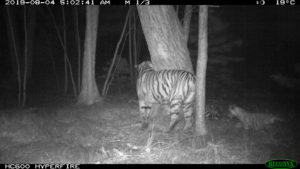In this final report from Lazovsky for activities and impacts in 2019, the ZSL team report on a holistic programme for tiger conservation that has secured a stable population of Amur tigers in the area.
In 2019, ZSL worked with partners to conduct tiger population monitoring, implement improved management plans that have increased the effectiveness of anti-poaching activities in the area, and continued wildlife veterinary capacity building and strategic planning.
Tiger population monitoring results for 2019 revealed a stable population and good reproduction. Preliminary results for 2020 show an increase in adult tigers after several years of good reproduction. Monitoring efforts in the unprotected area between LZ and ZT provided evidence that tigers are surviving and reproducing there as well.
The programme focused on combating threats in protected areas (most importantly poaching and wildfires) which contributed to a stable tiger and prey numbers, verified by effective monitoring results. The continued success of these conservation activities will ensure a source of tigers for dispersal into adjacent unprotected areas with fewer tigers.
Project activities and key achievements:
- 2019 tiger survey operated 60-paired camera trap stations in Lazovsky Zapovednik (LZ), 28 in Zov Tigra National Park (ZT), 25 in Medved Hunting Lease, and eight in Southern Valley Hunting Lease (SVHL), over 90 day-periods. Forty camera traps are left in LZ and ZT all year round.
- Results from the combined areas estimated 18-22 adult tigers.
- Also identified 1 subadult male and five new litters of cubs born in Spring-Summer 2018 and still travelling with their mothers at the end of this survey.
- Two new litters were born in summer 2019 with 3 and 2 cubs.
- Records have revealed the territorial takeover by a new male tiger, from a 14-year old male who held his territory for 11 years
- 15 year old tigress – the oldest recorded territorial female Amur tiger, had her 5th litter.
- A total of thirty-eight rangers in 7 groups patrolled an average of 27 days and 13 night patrols per month, walking 304 km per month, driving 1,441 km per month, and boating along the seashore 39 km per month (the sea is closed from November – May), to detain 19 intruders, dismantle 3 poacher camps, and remove 3 small leghold traps (meant for sable) across the region.
- The team collaborated to implement SMART* in the Protected Areas by providing a computer Database Specialist responsible for SMART data management and monthly reporting.
- The team paid ranger per diems and patrol logistics including equipment, uniforms, and fuel for patrol and project vehicles.
- Support was provided to rapid response teams (RRT) to respond to illegal incursions within the remote Protected Areas.
- In 2019, RRTs were equipped with 2 additional GMS poacher cams and 10 regular poacher cams for use with cell service is lacking.
- Three new inspectors were trained to use ATV and snowmobiles.
- 10-15 students and post-graduates trained per week during 3-4 hour lessons on practical training at the Primorskaya State Agricultural Academy (PSAA) centre, to gain experience with specialists on wildlife disease sampling and post mortems for disease diagnostics.
- Postmortems for disease diagnostics performed on 9 tigers and 40 prey species (deer and wild boar) during forensic examinations in 2019.
- 3 publications; two published and 1 in press. Produced two publications on wildlife disease risk assessment incorporating 12 years of wildlife disease monitoring results.



